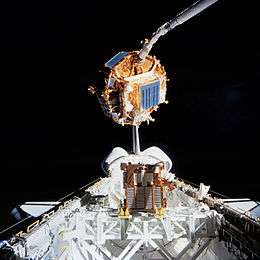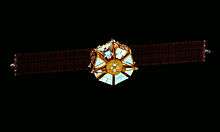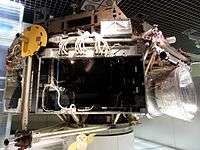Space Flyer Unit
 | |
| Mission type | Technology |
|---|---|
| Operator |
NASDA ISAS NEDO USEF |
| COSPAR ID | 1995-011A |
| SATCAT № | 23521 |
| Website |
www |
| Mission duration | 10 months |
| Spacecraft properties | |
| Manufacturer | Mitsubishi Electric |
| Launch mass | 3,846 kilograms (8,479 lb) |
| Landing mass | 3,492 kilograms (7,699 lb) |
| Start of mission | |
| Launch date | 18 March 1995, 08:01 UTC |
| Rocket | H-II 3F |
| Launch site | Tanegashima Yoshinobu 1 |
| End of mission | |
| Recovered by |
Space Shuttle Endeavour STS-72 |
| Recovery date | 13 January 1996 |
| Landing date | 20 January 1996, 07:41:41 UTC |
| Landing site | Kennedy SLF Runway 15 |
| Orbital parameters | |
| Reference system | Geocentric |
| Regime | Low Earth |
| Perigee | 470 kilometres (290 mi) |
| Apogee | 492 kilometres (306 mi) |
| Inclination | 28.4 degrees |
| Period | 94.22 minutes |
| Epoch | 17 April 1995[1] |

The Space Flyer Unit (宇宙実験・観測フリーフライヤ Uchū Jikken-Kansoku Free Flyer) was a spacecraft which was launched by Japan on Mar. 18, 1995.[2]
Technical data

The Space Flyer Unit was launched from Tanegashima Space Center from a H-II vehicle.[2] It was carrying testing materials and research data that held value to NASA. They retrieved the data from the Space Flyer Unit by Space Shuttle Endeavour on Jan. 20th, 1996 (which was 10 months after the Space Flyer Unit was launched.[2] The idea behind the implementation of the SFU was a joint effort by multiple major corporations. The ones that were involved with the launch were Institute of Space and Astronautical Science, the National Space Development Agency, and Ministry of International Trade and Industry.[3]
After the shuttle returns the SFU from space, the SFU is transported to Japan and refurbished for the next flight.[4]
Purpose
The original purposes behind the SFU were to[5]
- Allow researchers better access to space research conditions.
- Give researchers a group experimental facility.
- Be able to reuse the SFU to save money
- Retrieve data
Technology
A variety of systems that were operational within the SFU had never been implemented before. Equipment on board supported an infrared telescope, two-dimensional solar array, high voltage solar array, space plasma diagnosis, electric propulsion, material experimentation, gas dynamics, gradient heating chemicals, isothermal heating furnace and more.[6] The core system that was built into the SFU contained an octagonal aluminum truss. Inside of that were eight boxes of trapezoidal shape.[6] The SFU was connected directly to the Kagoshima Space Center.[7]
Experimentation data
There were a number of various types of experiments that were performed on board the SFU during its launch life cycle. Those experiments, and light data related to them are listed below.
- Infrared Telescope in Space (IRTS) - The IRTS experiment was performed by the infrared telescope that was aboard the SFU. The intent was to produce important information into the history of the universe and structure of the milky way galaxy. The telescope had a super fluid helium cooling fan built into it to prevent it from overheating.[8]
- 2D Array - The 2d array system was launched as a small module inside of the SFU. This experiment was deployed to show that large structures could (in fact) be built in space.[9]
- HVSA - The Solar Array was a power source put into this system to head up multiple experiments. It is used to test the creation of "electricity" in the denseness of space from the use of technology only.[10]
- SPDP - This was used on the SFU to test things going really fast in space. SPDP stands for (Space Plasma Diagnostic Package) and it was deployed with different sensors to check the effects of speed on the denseness of gravity.[11]
- EPEX - This hardware that was built into the SFU was meant to do experiments related to fuel creation and management in space.[12]
- MEX - This software was meant to review and research the effects of various types of liquid within a space environment.[13]
- BIO - This test required taking live species into space. It involved observing an egg hatch in deep space.[14]
References
- ↑ McDowell, Jonathan. "Satellite Catalog". Jonathan's Space Page. Retrieved 29 October 2013.
- 1 2 3 - Main Reference-Main Reference
- ↑ Chronology Data-Chronology Data
- ↑ "SFU : Space Flyer Unit". Archived from the original on 2016-08-01. Retrieved 2016-08-01.
- ↑ Purposes-Purposes
- 1 2 Experiment Data 1-Experiment Data 1
- ↑ Experiment Data 2-Experiment Data 2
- ↑ Irts Data-IRTS Data
- ↑ 2d array data-2d Array Data
- ↑ hvsa data-hvsa data
- ↑ Sdpd data-Sdpd data
- ↑ epex data-epex data
- ↑ mex-mex data
- ↑ bio-Bio
See also
External links
| Wikimedia Commons has media related to Space Flyer Unit. |